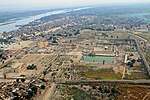Great Hypostyle Hall



The Great Hypostyle Hall is located within the Karnak temple complex, in the Precinct of Amon-Re. It is one of the most visited monuments of Ancient Egypt. The structure was built around the 19th Egyptian Dynasty (c. 1290–1224 BC).[1] Its design was initially instituted by Hatshepsut, at the North-west chapel to Amun in the upper terrace of Deir el-Bahri. The name refers to hypostyle architectural pattern.
The Great Hypostyle Hall covers an area of 5,000 m2 (54,000 sq ft). The roof, now fallen, was supported by 134 columns in 16 rows; the 2 middle rows are higher than the others (being 10 metres (33 ft) in circumference and 24 metres (79 ft) high).
The 134 papyrus columns represent the primeval papyrus swamp from which Amun; a self-created deity, arose from the waters of chaos at the beginning of creating.
The hall was not constructed by Horemheb, or Amenhotep III as earlier scholars had thought but was built entirely by Seti I who engraved the northern wing of the hall with inscriptions. Decoration of the southern wing was completed by the 19th dynasty pharaoh Ramesses II. A series of succeeding pharaohs added inscriptions to the walls and the columns in places their predecessors had left blank, including Ramesses III, Ramesses IV and Ramesses VI. The northern side of the hall is decorated in raised relief, and was mainly Seti I's work. The southern side of the hall was completed by Ramesses II, in sunk relief although he used raised relief at the very beginning of his reign before changing to the sunk relief style and re-editing his own raised reliefs. Ramesses II also usurped decoration of his father along the main north-south and east-west processional ways of the hall, giving the casual observer the idea that he was responsible for the building. However, most of Seti I's reliefs in the northern part of the hall were respected.
The outer walls depict scenes of battle, Seti I on the north and Ramesses II on the south. Although these reliefs had religious and ideological functions, they are important records of the wars of these kings. On another wall adjoining the south wall of the Hall is a record of Ramesses II's peace treaty with the Hittites that he signed in Year 21 of his reign.
In 1899, 11 of the massive columns of the Great Hypostyle Hall collapsed in a chain reaction, because their foundations were undermined by ground water. Georges Legrain, who was then the chief archaeologist in the area, supervised the rebuilding that was completed in May 1902. Later, similar work had to continue in order to strengthen the rest of the columns of the Temple.
See also
Notes
- ↑ Kleiner, Fred S. Gardner's Art Through the Ages. 14th. Boston: Wadsworth, 73. Print.
References
External links

